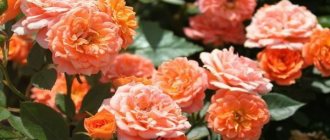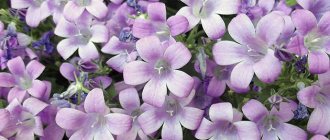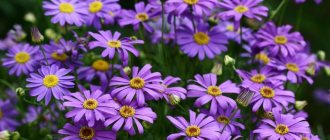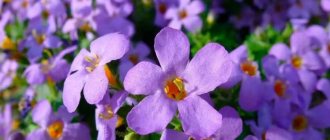The aster plant is represented by herbaceous annuals and perennials, and it belongs to the Asteraceae or Asteraceae family. According to information taken from various sources, this genus includes 200–500 species, most of which are naturally found in Central and North America. The plant came to Europe in the 17th century; it was brought secretly from China by a French monk. The name aster is translated from Latin as “star”. There is a Chinese legend about this flower, which says that 2 monks decided to reach the stars, they climbed higher and higher to the highest mountain in Altai, after many days they found themselves at the top, but the stars still remained distant and inaccessible. Exhausted by the hard road without food and water, they returned to the foot of the mountain, and a beautiful meadow with wonderful flowers opened before their eyes. Then one of the monks exclaimed: “Look! We were looking for stars in the sky, but they live on earth!” Having dug up several bushes, the monks brought them to the monastery and began to grow them, and it was they who gave them the stellar name “asters”. Since that time, such flowers in China have come to be considered a symbol of elegance, charm, beauty and modesty. Aster is the flower of those born under the sign of Virgo, a symbol of dreams of the unknown, a guiding star, a talisman, God's gift to man...
A little history and mysticism
The aster plant was known to the inhabitants of ancient Rome and Greece. In those distant times, charming buds decorated houses and temples; the flower itself was considered a reliable amulet against evil forces and was dedicated to Aphrodite, the goddess of love, unfading beauty and fertility.
Some legends attribute the origin of flowers to the goddess Persephone, who was imprisoned with her unloved husband in the farthest dungeons of the Kingdom of the Dead and could only sometimes rise to the surface of the earth. The tears of the goddess of spring, who saw the couple in love, turned into light stars, and later flowers with radiant petals grew at the site of their fall.
Chinese legends associate the appearance of the flower with monks who decided to reach the sky in order to take a closer look at the stars that litter the sky. When they failed, they found a charming clearing that greeted them with gentle rays of unusual flowers. Taking them as a sign from above, the clergy dug up several bushes and took them to their native monastery so that everyone could enjoy the lovely view of the earth’s stars.
China acquired the right to be called the homeland of asters, and in modern Europe, the solemn ascension of flowers to the podium began in the 17th century, where they were brought by French monks traveling around the world.
The largest range of unpretentious flowers is located in Central and North America, and numerous representatives of this family can be found everywhere.
Asters are still considered symbols of beauty and light charm, sophistication and grace to this day. They give special benefits to people born under the sign of Virgo, helping them overcome all life’s troubles, bringing love and good luck.
Europeans, on the contrary, consider asters to be a flower of sadness and sadness.
What plants are combined with?
- The bush aster is placed in the flowerbed next to other representatives of the large Asteraceae family, which require similar care. The proximity to garden flowers and buds until late autumn has a beneficial effect on the development of the herbaceous plant, including:
- marigold;
- petunias;
- chrysanthemums;
- dahlias;
- phlox.
When designing floral compositions, the bush aster is combined with thuja, juniper, dwarf spruce, and cypress. To prevent conifers from taking moisture from the flower, plants are placed at a distance from each other, and not close.
Description of the plant
The plant has a straight stem, on the flat surface of which there are small fluffy hairs and carved leaves. The buds appear on the side stems and are small baskets tightly wrapped in lush green leaves.
The baskets themselves may have one or several rows of fluffy petals, but the more rows there are, the prettier and more magnificent the bud looks.
The height of the plant ranges from 15 centimeters to almost a meter, which makes it possible to use them as the main decoration of a flower bed or its edging, plant noble flowers in a picturesque group or individually, and decorate them with other plants.
Cut buds retain their charming appearance for a long time, which makes them the favorite flowers of many housewives.
Various types and varieties of unpretentious plants will help you decorate your garden in the most unusual way, filling the ground with all the colors of the rainbow, as is clearly shown by all sorts of photos of asters.
Varieties and types of perennial asters
Among the popular varieties are perennial aster flowers, the varieties and photos of which are presented below.
Alpine
The Alpine aster variety is a plant that belongs to the early flowering species. Already in May, the first multi-colored buds appear, which are planted on low (about 40 cm) stems. The aster delights with its riot of colors for about a month, but if the site is chosen correctly for it (sunny and dry), then the flowering period can be 1.5 months. Alpine aster has several varieties:
- Alba. It has small semi-double flowers (3 cm in diameter) of snow-white color;
- Glory. Buds up to 4 cm in diameter, sky blue with a bright yellow center;
- Goliath. Purple flowers on elongated stems. The flower is used to decorate rockeries and alpine slides;
- Dunkle Schone. The flowers are dark purple and small in size. The culture is frost-resistant;
- Rosea. Delicate pink petals located on medium-length stems delight the eye for about 3 months. The first flowers appear in June.
Italian
The Italian aster cannot boast of a large number of colors and shapes; it is less resistant to adverse environmental influences, but is very popular. Among the best varieties are:
- King George - has a lilac color, narrow-petalled inflorescences;
- Coerulea - characterized by a lilac-blue color;
- Gnome - a variety intended for cutting, has soft lilac inflorescences;
- Rosea – suitable for cutting, has a bright pink color;
- Lady Hindlip – has light pink pastel flowers;
- Henrich Seibert - a brighter pink flower with narrow petals;
- Kobold - has large inflorescences of a lilac-purple hue;
- Herman Lens – large purple flowers.
New England (American)
The main difference between the New England aster is its thick shoots, which can reach 150 cm. They bloom late, love nutritious soil and good care.
- Browman. Lilac-violet flowers appear in September, forming lush clusters;
- Dr. Eckener. The variety's red-violet buds, 4 cm in diameter, bloom at the end of September and delight with their lush inflorescences for just over a month;
- Lily Fardell. Rich pink color, medium sized inflorescences. Great for making bouquets. The stem is literally strewn with buds, which makes the variety the most unique;
- Rothe Stern. They appear to be double inflorescences of a carmine hue. Flower buds are large, bright and expressive. Flowering occurs in mid-autumn.
New Belgian (Virginian)
In the New Belgian aster, the main difference is the type of stems. They are quite tall, but not all have a lot of foliage. Some stems appear completely bare, while neighboring ones are completely covered with greenery.
- Ballard. Small flowers of a bright pink hue. Culture can become a decoration for any flower display. It looks impressive even when planted alone;
- Beechwood Ravel. A bush about a meter in height, on which purple inflorescences are majestically placed, contrasting with green petals. Flowering lasts more than 30 days;
- Oktoberfest. A variety of asters of a blue hue, semi-double inflorescences, diameter 4 cm;
- Saturn. Lush flowers, painted in blue tones. The bush is tall - at least 130 cm, flowering is short - less than a month.
Attention! Aster has special significance in many countries. In Greece - as an amulet, in Hungary - as a symbol of autumn, in China - symbolizes infallibility, in Japan - high thoughts, in France - sorrow.
Bessarabian
Bessarabian aster belongs to those varieties that do not grow more than 80 cm, but have many inflorescences painted in lilac shades. Their main difference is the dark brown core.
Bush
Bush asters are distinguished by a variety of colors and compact shape. They can be trimmed to give the desired shape to the bush.
- Blue Bird. It is a small bush that grows up to 25 cm. The flower petals have an interesting color: the sky blue shade turns into lilac. Blue Brad is a variety that is considered ideal for decorating borders;
- Venus. A 20-centimeter bush, which is a good choice for constructing hanging compositions and planting in floor containers. Purple-pink buds appear in September and delight with their flowering throughout the month;
- Dwarf Nancy. It has bushes up to 25 cm in height, the inflorescences of which are painted in lilac shades, the petals have a reed shape;
- Niobe. A variety of snow-white asters that grow up to 30 cm. The main decoration of the white petals is the bright yellow center;
- Royal Ruby. A purple-ruby flower, which many gardeners call royal. The flowers are small in size, so this variety is often used to create spectacular bouquets.
Agerate-shaped
The agerate-shaped variety of asters is less popular. And this is due to the fact that this species is not decorative, but medicinal. The bushes grow up to a meter in height, the stems are straight. The buds are small, forming shields, their color is blue.
Important! In Agerata aster, all parts of the plant are medicinal.
Globular
Among the best varieties of asters, one can distinguish the spherical one. This perennial flower is a regular-shaped ball formed by small but numerous pink inflorescences. The height of the bush is no more than 50 cm, which makes this variety of asters extremely aesthetic in appearance.
Terry
The color of double asters can be different, but they have one thing in common - thick, ball-like inflorescences.
Heather
The bushes, about 100 cm high, are presented in the shape of a pyramid, the shoots bend down. The flowers are numerous, but quite small, and bloom in early September. The shades are predominantly light, mainly pink and white. Culture is actively used to decorate public gardens, gardens and parks.
Tatar
Tatar aster is a medicinal and decorative variety. Its tall bushes (about 1.5 m) are strewn with small inflorescences of a pale blue or light pink hue. In the middle there is a bright yellow spot, which gives the variety a decorative appearance. The Tartarian aster prefers cool and damp places.
Selecting a location
Planting an aster and its future life begins with determining the most suitable place of residence for the plants. Such a place will be an area well illuminated by the sun's rays, or a small partial shade with loose soil.
The seedlings will feel great in the place where marigolds or calendula grew, but will not be very accepting of the territory that in the past was given over to gladioli, tulips, potatoes or tomatoes.
Application of Asters in garden design
These beautiful flowers are used as border borders. Plants highlight garden paths, creating beautiful compositions from other flora. For example, white Asters will organically complete a flower bed planted with flowers in orange or red tones.
These representatives of the flora are widely used not only for decorating garden space, but also for making bouquets. Persistent when cut, they often decorate autumn holidays and are the most popular and sought-after flowers of this season.
Landing
Planting and caring for aster in open ground is not difficult and is accessible even to novice gardeners.
Seedling method
Plant cultivation begins in early spring (mid-March), when aster seeds are sent into the ground for germination indoors. The seeds germinate quite quickly without additional movements from the hostess, so the first shoots can appear already 3-4 days after planting.
As the plants grow, they are hardened off. Transplantation to a permanent place is carried out in late April-early May.
Seeds
Unpretentious flowers can also be grown by planting seeds in open ground, but this is done after the temperature does not steadily drop below 10 degrees. In this case, the seeds are placed in furrows, lightly sprinkled with soil and covered with mulch.
When sprouts appear, the protective layer of grass and leaves is removed. But it should be taken into account that bushes grown in this way will bloom a couple of weeks later than plants obtained by seedlings.
Planting in the ground can also be done in late autumn. In this case, the seeds are placed in frozen ground in pre-prepared grooves and sprinkled with soil. Sprouts that hatch in the spring have a much higher endurance threshold.
Flowering will begin 90-110 days after sowing, depending on the variety.
How to propagate bush aster
Seeing in the photo a lush low plant dotted with bright star flowers, which looks especially stunning against the backdrop of nature preparing for winter, summer residents are interested in how the shrub aster reproduces and what needs to be done to decorate the site with such a miracle.
Growing from seeds
It is problematic to collect seeds for sowing from autumn varieties of perennials that bloom late, since they do not always have time to ripen, but bush aster seeds are sold in gardening centers and in online stores. Propagating a flower in this way, although it requires patience, allows you to grow strong bushes.
To breed a perennial aster in the yard or country house:
- The area dug up for sowing is loosened, rows are made up to 20 mm deep with an interval of about 20 cm.
- The soil in the furrows is irrigated, when the water is absorbed, seeds soaked in a solution of fungicide or potassium permanganate are laid out, trying to keep the distance between them at least a centimeter.
When the flowers grow 2 or 3 leaves, to prevent thickening of the planting, the aster is broken through, leaving 15 cm between the bushes.
Perennials are sown not only in spring, but also at the end of autumn, when the ground freezes, choosing one of the following methods:
- scatter seeds in the snow;
- scattered over the surface of the soil;
- placed in holes that are dug before frost.
The grains do not germinate before the onset of warm weather, and in March, along with the melting snow, they go deeper. Bush flowers planted before the onset of winter are strong and resilient. to diseases.
Division
As the aster grows, it loses its decorative value, begins to bloom less profusely, and requires replanting, which allows summer residents to plant the flowers they like. In the spring, before the onset of warm weather, the bush is dug up, cleared of soil and the root with strong shoots and two or three stems is divided into 3 or 2 parts. The sections are sprinkled with ash or treated with a solution of potassium permanganate.
The resulting new bushes are transplanted into the hole, watered abundantly and cared for as for adult plants. Four-year-old asters and older are used for division.
Propagation by cuttings
Another method is suitable for propagating autumn flowers. In the spring, a stem 15 to 20 cm long is cut from the top of the bush at an angle and shortened to the first bud. A bush aster cutting is dipped into a solution of a growth stimulator and a day later planted in soil diluted with sand and fertilized with peat.
If several branches of the bush aster are cut for propagation, an interval of 0.2 m to 30 cm is left between each one. The cuttings are placed at an angle to a depth of 10 cm. The seedlings are watered abundantly for the first month, when strong roots form and young shoots appear, the perennial flower ceases to need water frequent irrigation.
Care
Asters will not require much time and effort to care for. Adult bushes are not afraid of lower temperatures, but prefer warmth from 18 to 25 degrees.
You should not get too carried away with watering plants, this can lead to plant diseases, so on heavy soils the solution to the question of how to water asters is carried out with the help of high-quality drainage. Asters do not like spraying, which significantly saves housewives’ energy. But the soil should not be allowed to dry out.
Mineral fertilizers or well-diluted chicken manure are used to feed the plant. But its use is recommended on really poor soils. The first application of fertilizer is carried out several weeks after transplantation to a permanent place, the second and third are timed to coincide with the appearance of buds and their flowering.
Loosening and weeding will help provide the aster with more oxygen and nutrients. To prevent the soil from becoming crusty, the soil is loosened after each watering or rain. Weed removal is done as needed.
When is it not recommended to plant asters?
There are days when it is not advisable to plant asters for seedlings in 2022. Astrologers have identified periods during which low germination and poor development of germinated seedlings will be observed. Unfavorable days are shown in the table and apply to both annual and perennial varieties.
| January | 11, 24-26 |
| February | 3, 8-9, 17, 21-23 |
| March | 9, 19-21, 24, 27 |
| April | 8, 16, 17, 21, 23 |
| May | 7, 13, 14, 22, 23 |
| June | 6, 9, 10, 21 |
Other periods, with the exception of those recommended for planting work, are called neutral. Sowing aster for seedlings is possible, but the quality of the resulting seedlings will not have any outstanding features.
Cyclic change of moon phases in 2022 - unfavorable days for planting and transplantation
Care after flowering
Annual plants (and most of them) are dug up and burned, perennial bushes are left in place or moved to a new site. The planting site must be changed at least once every five years.
It is not necessary to cover the plant for the winter; asters have fairly good resistance to frost.
Unpretentious, colorful, familiar and unusual asters can easily and quickly decorate your garden and cottage, filling flower beds and borders.
The best varieties of annual asters
Late and early varieties of asters, which are classified as annuals, are also very popular among gardeners. The most popular is the Chinese aster, which has at least 600 subspecies of various colors, shapes and structures.
Among the best and most popular varieties of Chinese annual aster are the following types:
- Galaxy. This aster has large needle-shaped double inflorescences (up to 10 cm in diameter), the shades of which can be very diverse. The bushes grow about 60 - 70 cm in height;
- Rosanna. Aster is a peony-type plant that grows up to 65 cm in height. The color of this species is pink, the petals on the buds are tightly pressed to each other, which creates the effect of splendor;
- Pompom. Aster is very similar to peonies or chrysanthemums and has double inflorescences of various shades.
Photos of asters
Prices for aster seeds
The cost of seeds depends on their variety. The price differs little in the regions. In retail and online stores you can find planting material from 13-15 rubles.
Instances with beautiful decorative characteristics will cost more - from 35 to 50 rubles. In any case, aster seeds are available for purchase by any garden plant lover.
By planting asters with seedlings, you can get strong plants. They will decorate flower beds until frost. At the same time, even novice gardeners will be captivated by the process of growing seeds.











